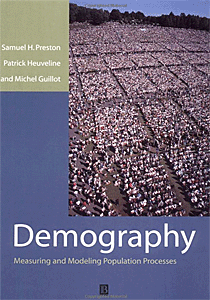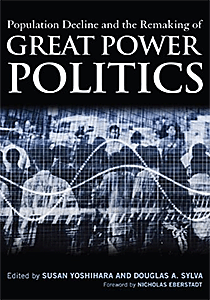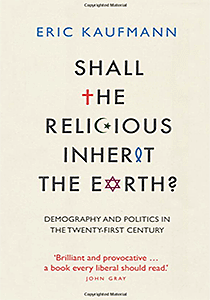|
|
|
Below is a list of selected on-line data bases, EXCEL tables and
pdf-documents for the study of global demographic structures and trends. |
|
|
|
Recently added data links: |
|
|
|
Refugees, asylum seekers, internally displaced persons
(Added 10 October 2014) |
|
|
|
Probabilistic Population Projections
United Nations Population Division.
These are
the 2nd Revision of Probabilistic Population Projections for all countries of the world prepared by the Population
Division of the United Nations Department of Economic and Social Affairs (DESA). While the 1st Revision, published in
early 2012, was based only on probabilistic projections of total fertility, this 2nd Revision also includes probabilistic
projections of life expectancy at birth for all countries that do not have a high prevalence of HIV/AIDS infections. The
probabilistic projections are based on the historical estimates of population by age and sex, fertility and mortality
between 1950 and 2010 from the 2010 Revision of the World Population Prospects.
Methodology
Software
Input: Fertility Change Model
Input: Fertility Projection
Input: Life Expectancy at Birth - Females
Input: Life Expectancy at Birth - Males
Results: Total Population by country
Results: Population Age 0-14 by country
Results: Population Age 15-64 by country
Results: Population Age 65+ by country |
|
|
|
World Population Prospects: The 2012
Revision
United Nations Population Division
The 2012
Revision of the World Population Prospects is the twenty-Third round of global demographic estimates and projections
undertaken by the Population Division of the United Nations Department of Economic and Social Affairs of the United
Nations Secretariat. The world population prospects are used widely throughout the United Nations (UNFPA, UNDP, WHO, FAO,
UNICEF, UNESCO, etc.) and by many international organizations (The World Bank, IMF, etc.), research centers, academic
researchers and the media.
This is the original set of demographic estimates and projections for all countries of the world, which is used for
numerous derived indexes and analytic reports and papers by various UN agencies and research centers.
Methodology
Volume I
Volume II
Tables in EXCEL-Format: Population
Tables in EXCEL-Format: Fertility
Tables in EXCEL-Format: Mortality (Life Expectancy)
Tables in EXCEL-Format: Migration
Tables in EXCEL-Format: Annually interpolated data
Tables in EXCEL-Format: Special aggregates
Demographic Country Profiles |
|
|
|
Demographic and Health Surveys (DHS)
USAID
The Demographic and Health Surveys (DHS) Program has collected, analyzed, and disseminated
accurate and representative data on population, health, HIV, and nutrition through more than 300 surveys in over 90
countries:
Datsets |
|
World Population & Census Programme
United Nations Statistics Division
List of all population and housing censuses worldwide. |
|
Demographic Yearbook
United Nations Statistics Division
The Demographic Yearbook includes demographic data as reported by UN member
countries. For demographically consistent population estimates and projections see: United Nations, Population
Division:
World Population Prospects and
World
Urbanization Prospects. |
|
World Population Datasheet
Population Reference Bureau
The World Population Data Sheet offers detailed information
on 20 population, health, and environment indicators for more than 200 countries. Data include: wealth and income
disparity, HIV/AIDS prevalence, percent of population with access to improved sanitation, and more. The demographic data
are mostly taken from the estimates of the United Nations World Population Prospects.
More ... |
| |
| |
| |
|
|
Advertisement: Smart Books from Amazon.com |
 |
 |
 |
 |
|
Samuel Preston / Patrick Heuveline / Michel Guillot (2000) Demography: Measuring and Modeling Population Processes. Wiley-Blackwell |
Susan Yoshihara / Douglas A. Sylva (Eds.) (2011) Population
Decline and the Remaking of Great Power Politics.
Potomac Books |
Stephen Emmott (2013) Ten Billion.
Vintage |
Eric Kaufmann (2011) Shall the Religious Inherit the Earth?
Demography and Politics in the Twenty-First Century. Profile Books |
|
In Association
with
Amazon.com |
|
|
| |
| |
| |
|
Simple Online Data Archive for
Population Studies
PennState University, USA
The Simple Online Data Archive for Population Studies is the Population Research Institute's
data archive. Datasets are arranged in collections by title. Within each collection, users may view descriptive
information including links to abstracts and originating agencies or investigators; search the content of each collection
for relevant variables; search across collections for variables; view accompanying electronic documentation; and finally,
extract for download a personally tailored analysis-ready subset of a data collection in a format of their choosing - SAS,
Stata, or SPSS dataset and comma or tab delimited format.
Data Collections |
|
INDEPTH Network
42 member network of Demographic Surveillance Systems
INDEPTH is a pioneer in health and population research, providing answers to some of the
most important questions in development. Through its global network of health and demographic surveillance system (HDSS)
field sites in Africa, Asia and Oceania, it is capable of producing reliable longitudinal data not only about the lives of
people in low- and middle-income countries, but about the impact on those lives of development policies and programmes:
INDEPTH Data Depository |
|
Multiple Indicator Cluster Surveys
(MICS)
UNICEF
UNICEF assists countries in collecting and analyzing data in order to fill data gaps for
monitoring the situation of children and women through its international household survey initiative the Multiple
Indicator Cluster Surveys (MICS). Since the mid-1990s, the MICS has enabled many countries to produce statistically sound
and internationally comparable estimates of a range of indicators in the areas of health, education, child protection and
HIV/AIDS. Results from MICS, including national reports and micro level datasets, are widely disseminated after completion
of the surveys and can be downloaded at this website.
Data Files |
|
Human Fertility Database
V. Shkolnikov, T. Sobotka, D. Jdanov, A. Jasilioniene, D. Kostova, P. Grigoriev, K.
Kubisch, S. Gellers-Barkmann
The Human Fertility Database (HFD) is a joint project of the Max Planck Institute for
Demographic Research (MPIDR) in Rostock, Germany and the Vienna Institute of Demography (VID) in Vienna, Austria, based at
MPIDR. The database provides free access to detailed, well-documented and high-quality data on period and cohort fertility
and thus to facilitate research on changes and inter-country differences in fertility in the past and in the modern era.
The HFD is entirely based on officially registered birth counts by calendar year, mother's age (and/or cohort) and
(whenever possible) biological birth order.
Data Files |
|
Human Mortality Database
J.R. Wilmoth, V. Shkolnikov, M Barbieri)
The Human Mortality Database (HMD) was created to provide detailed mortality and population
data to researchers, students, journalists, policy analysts, and others interested in the history of human longevity. The
project began as an outgrowth of earlier projects in the Department of Demography at the University of California,
Berkeley, USA, and at the Max Planck Institute for Demographic Research in Rostock, Germany. It is the work of two teams
of researchers in the USA and Germany, with the help of financial backers and scientific collaborators from around the
world.
Data Files |
|
Integrated Public Use Microdata Series
(IPUMS)
Minnesota Population Center, National Statistical Offices
IPUMS-International is an effort to inventory, preserve, harmonize, and disseminate census
micro-data from around the world. The project has collected the world's largest archive of publicly available census
samples. The data are coded and documented consistently across countries and over time to facilitate comparative research.
IPUMS-International makes these data available to qualified researchers free of charge.
Data Files |
| |
| |
| |
|
|
Advertisement: Smart books from Amazon.com |
 |
 |
 |
 |
 |
|
Massimo Livi-Bacci (2012) A Concise History of World
Population. Wiley-Blackwell, 5th Edition. |
Ronald Lee, Andrew Mason (2013): Population Aging and the Generational Economy: A Global Perspective. Edward Elgar Pub.
|
Peter S. Heller (2003)
Who Will Pay? Coping With Aging Societies, Climate Change, and Other Long-Term Fiscal Challenges. International Monetary Fund (IMF) |
World Bank (2014)
World Development Report 2014: Risk and Opportunity - Managing Risk for Development.
World Bank Publications |
William Easterly (2014)
The Tyranny of Experts: Economists, Dictators, and the Forgotten Rights of the Poor.
Basic Books |
|
In Association
with
Amazon.com |
|
| |
| |
| |
|
Refugees, Asylum Seekers, Internally
Displaced Persons
United Nations High Commissioner for Refugees - UNHCR
The database currently contains data about UNHCR's populations of concern from the year 2000
up to 2013 and you can use it to investigate different aspects of these populations: their general composition by location
of residence or origin, their status (refugees, asylum seekers, internally displaced persons, etc.), their evolution over
time. |
|
United States Demography
Social Explorer, Free Edition
Population data (census) from 1790 to 2012 in maps and tables for the United States of
America |